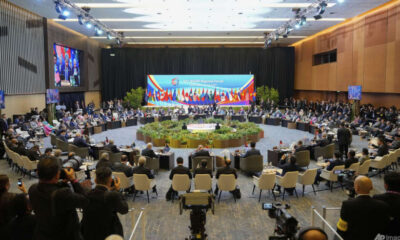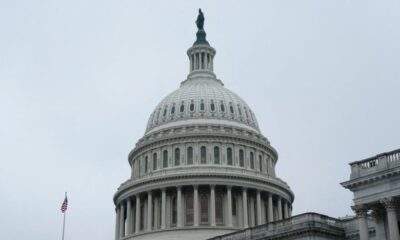Business
Dollar’s Dominance at Risk: Structural Weaknesses Emerge

The US dollar is facing unprecedented challenges that could reshape its status as the world’s dominant currency. A combination of domestic fiscal issues and a global shift away from dollar reliance has pushed the currency to a crucial juncture. Analysts warn that a significant breakdown at this point could indicate a long-term decline in its global standing.
Structural flaws in the US economy have contributed to these pressures. According to projections from the Congressional Budget Office (CBO), public debt is expected to exceed 116% of GDP by 2034, largely due to structural deficits in mandatory spending programs like Social Security and Medicare. This is not merely a partisan issue; it reflects a demographic challenge due to an aging population coupled with political resistance to entitlement reform.
Recent fiscal policies have exacerbated these trends. For example, proposals from former President Donald Trump could add over $5 trillion to the national debt over the next decade, underscoring the urgency of the situation. The Federal Reserve now faces a complicated dilemma, as it grapples with a slowing economy and burgeoning inflation risks. In response, the Fed has cut interest rates, diminishing the dollar’s yield advantage and prompting markets to reassess its value.
Global Shifts and Alternatives to the Dollar
As the US grapples with its internal challenges, other nations have begun to explore alternatives to the dollar. The weaponization of trade and finance by successive US administrations has fueled a quiet but significant pushback against dollar hegemony.
Countries such as China and Russia are expanding trade networks based on their own currencies. The International Monetary Fund (IMF) reports that while the dollar constitutes approximately 58% of global reserves, this figure has been steadily declining over the past two decades. The notable shift is evident not only in reserve holdings but also in trade practices, with an increase in non-dollar transactions despite the yuan’s reserve share being below 3%.
A particularly noteworthy development has emerged from Saudi Arabia, historically the cornerstone of the petrodollar system since the 1970s. The Kingdom has indicated a willingness to accept other currencies for oil sales, marking a potential turning point. Additionally, the European Union is striving for “strategic autonomy,” with the euro already representing over 22% of global payments. Countries like India are also advocating for rupee-based settlements, while the expanding BRICS+ bloc provides a framework for coordinated efforts to reduce reliance on the dollar.
Market Indicators and Future Outlook
The mounting pressures on the dollar are reflected in the long-term trends of the Dollar Index (DXY). Current data shows the index testing a vital support level between 96 and 97. Analysis from the Commodity Futures Trading Commission (CFTC) highlights a growing speculative positioning against the dollar, indicating a loss of fundamental confidence. A decisive break below this support could signal the end of the dollar’s secular bull run that began in 2008.
The current scenario draws parallels to the challenges faced by the dollar in the early 1970s, when persistent fiscal and trade deficits made it impossible to maintain the currency’s gold peg. Today, similar fiscal challenges and a global pushback against US financial supremacy raise critical questions about the dollar’s long-term viability.
The likely outcome is not an abrupt collapse but a gradual transition toward a multipolar currency landscape, where several key currencies—including the dollar, the euro, and the yuan—compete for influence. This shift could lead to increased volatility in currency markets and more complex hedging strategies for international corporations.
In the event of a severe systemic crisis originating outside the United States, the dollar could experience a temporary rally. The US Treasury market, despite its inherent weaknesses, remains the only significant global financial asset capable of absorbing a massive flight to safety. This dynamic reinforces the dollar’s role as a safe haven, albeit one that is increasingly challenged.
For investors, corporations, and governments, the message is evident: the era of assuming a consistently strong and stable dollar is over. Strategic planning must now account for a more fragmented and unpredictable currency environment. Central banks are likely to continue diversifying their reserves, corporations will need to enhance currency risk management strategies, and investors should seek opportunities beyond traditional dollar assets for long-term value preservation.
As the landscape evolves, the dollar’s reign is far from guaranteed. The ongoing shifts in both domestic policy and global economic dynamics will continue to shape its future.
-

 Lifestyle3 months ago
Lifestyle3 months agoHumanism Camp Engages 250 Youths in Summer Fest 2025
-

 Sports3 months ago
Sports3 months agoDe Minaur Triumphs at Washington Open After Thrilling Comeback
-

 Business4 months ago
Business4 months agoKenvue Dismisses CEO Thibaut Mongon as Strategic Review Advances
-

 Sports4 months ago
Sports4 months agoTupou and Daugunu Join First Nations Squad for Lions Clash
-

 Top Stories4 months ago
Top Stories4 months agoColombian Senator Miguel Uribe Shows Signs of Recovery After Attack
-

 World4 months ago
World4 months agoASEAN Gears Up for Historic Joint Meeting of Foreign and Economic Ministers
-

 Business4 months ago
Business4 months agoOil Prices Surge Following New EU Sanctions on Russia
-

 Health3 months ago
Health3 months agoNew Study Challenges Assumptions About Aging and Inflammation
-

 Entertainment3 months ago
Entertainment3 months agoDetaşe-Sabah Violin Ensemble Captivates at Gabala Music Festival
-

 Entertainment3 months ago
Entertainment3 months agoBaku Metro Extends Hours for Justin Timberlake Concert
-

 Business4 months ago
Business4 months agoU.S. House Approves Stablecoin Bill, Sends to Trump for Signature
-

 Top Stories4 months ago
Top Stories4 months agoRethinking Singapore’s F&B Regulations Amid Business Closures









